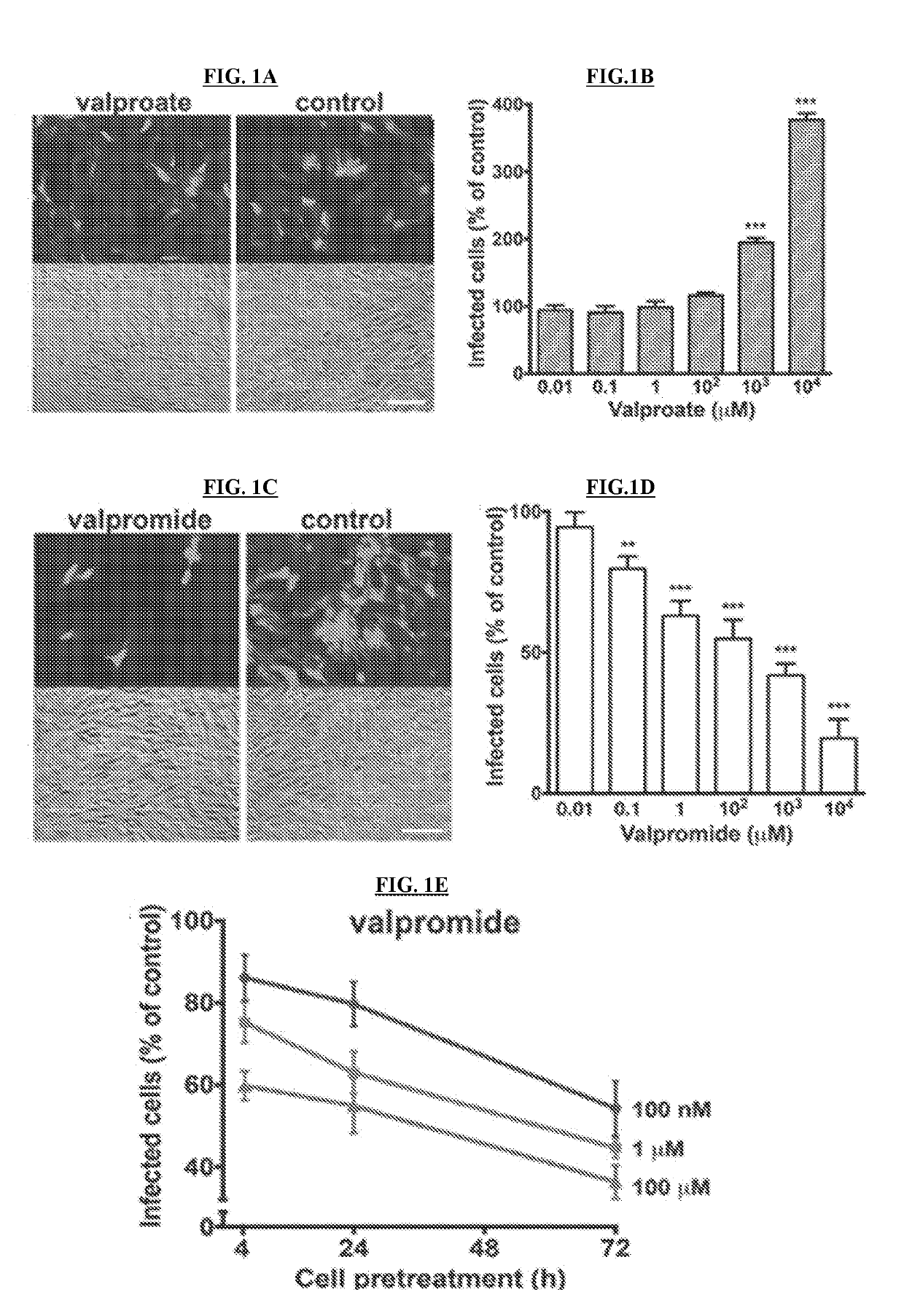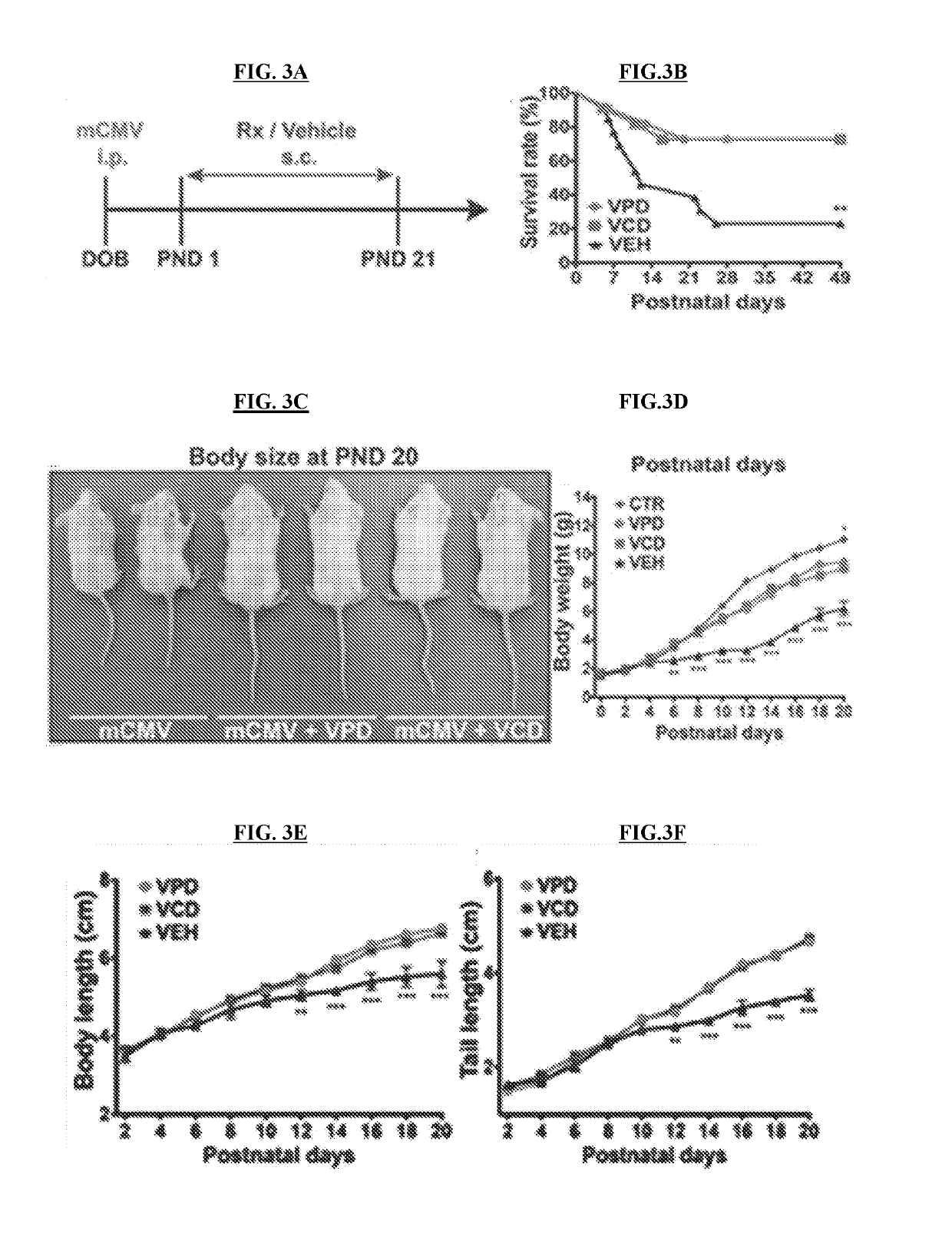Compositions and Methods for Treating Viral Infection in Mammals
a technology for mammals and compositions, applied in the field of compositions and methods for treating viral infection in mammals, can solve the problems of cmv infection, the most common and potentially life-threatening infectious complication in immunocompromised individuals, and the damage to the developing brain, so as to achieve no significant mood stabilizing and/or modifying
- Summary
- Abstract
- Description
- Claims
- Application Information
AI Technical Summary
Benefits of technology
Problems solved by technology
Method used
Image
Examples
example 1
A. Materials and Methods
Cells
[0146]NIH / 3T3 (CRL-1658) and Vero (CCL-81) cells were purchased from the American Type Culture Collection (ATCC) (Manassas, Va.), normal human dermal fibroblasts were obtained from Cambrex (Walkersville, Md.), Neuro-2a (CCL-131) were provided by A. Bordey (Yale University, New Haven, Conn.), and U-373 MG cells were a gift from R. Matthews (Syracuse, Conn.). Vero cells were grown and maintained in Eagle's Minimum Essential Medium (MEM) supplemented with 10% fetal bovine serum (FBS) and 1% pen / strep (Invitrogen, Carlsbad, Califo.). All the other cell lines were maintained in Dulbecco's modified Eagle's essential medium (DMEM) supplemented with 10% FBS and 1% pen / strep. Primary cultures of mouse glia were established using whole brain tissue harvested from P5 mice and maintained in DMEM (van den Pol, et al., 1999, J. Neurosc. 10948-10965). All cultures were kept in a humified atmosphere containing 5% CO2 at 37° C.
Viruses
[0147]A brief description of each vir...
example 2
A. Materials and Methods
[0176]Cell lines, Viruses, and Chemicals:
[0177]Normal human dermal fibroblasts (HDF) were obtained from Cambrex (Walkersville, Md.) and primary human fetal brain astrocytes were obtained from ScienceCell Research Laboratories (Carlsbad, Calif.). HDF cells were cultured in Dulbecco's modified Eagle's essential medium (DMEM) supplemented with 10% FBS and 1% pen / strep (Invitrogen, Carlsbad, Calif.). Human fetal astrocytes were grown in poly-L-lysine coated culture vessels and maintained in Astrocyte Medium (ScienceCell) supplemented with 2% FBS and 1% pen / strep. All cultures were kept in a humidified atmosphere containing 5% CO2 at 37° C.
[0178]For in vitro experiments, a recombinant human CMV (hCMV, Toledo strain) expressing enhanced green fluorescent protein (EGFP) under the control of the EF1-alpha promoter (EGFP-hCMV) was employed (Jarvis, et al., 1999, J. Virol. 73:4552-4560). Normal human fibroblasts were used to test viral EGFP expression, replication capa...
PUM
| Property | Measurement | Unit |
|---|---|---|
| Composition | aaaaa | aaaaa |
| Pharmaceutically acceptable | aaaaa | aaaaa |
Abstract
Description
Claims
Application Information
 Login to View More
Login to View More - R&D
- Intellectual Property
- Life Sciences
- Materials
- Tech Scout
- Unparalleled Data Quality
- Higher Quality Content
- 60% Fewer Hallucinations
Browse by: Latest US Patents, China's latest patents, Technical Efficacy Thesaurus, Application Domain, Technology Topic, Popular Technical Reports.
© 2025 PatSnap. All rights reserved.Legal|Privacy policy|Modern Slavery Act Transparency Statement|Sitemap|About US| Contact US: help@patsnap.com



